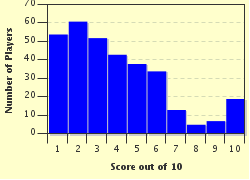Quiz Answer Key and Fun Facts
1. In your head (the feebleminded may use a calculator), divide the square of eight by the multiple of two of the cube root of twenty-seven, to which one has first been added. What number should you get?
2. Three couples attend marriage counselling. John is a mechanic, and loves Sue, who is a clerk. Harry is a teacher, and so is Isabel. James is a dentist, and Sally is a librarian. James plays golf at weekends, and Isabel reads. The quiz-lover won't let her husband's overalls into the house. The sailor always has wine aboard his yacht. Harry is a baseball fan, and drinks beer. John drinks orange juice, James prefers whisky. Sue enjoys a glass of wine, Sally likes doing quizzes on the internet. Sue goes clubbing, but John likes sailing. Sally's favourite drink is ginger ale, but Isabel prefers hot chocolate. A teacher is married to the baseball fan. To whom is James married?
3. I give you a series of letters. You tell me - what letter comes after the next in sequence? Here is the series:
L, Y, T, C, A, D, O, R, E...
4. The Jamaican Faithful Motor Corporation manufactures its Stevedore lorries
in five colours, arranged in production order as follows:
Red lorry, Yellow lorry, Green lorry;
Red lorry, Yellow lorry, Black lorry;
Red lorry, Black lorry, Green lorry;
Black lorry, Yellow lorry, Green lorry;
Red lorry, ___________ , and Green lorry.
Fill in the blank!
5. Three cavalry scouts are taken prisoner by Crazy Horse. (You must remember that scouts are smart people - they were only caught because they were surrounded and outnumbered.) Crazy Horse decides to set them a test. He lines them up in a row, one behind the other, and shows them 5 feathers: 3 eagle feathers and 2 crow feathers. One of any of these feathers is to be bound to each man's head, so that the last man in line can see two feathers, the middle one only one, and the man in front none at all. The first man who can correctly identify what kind of feather is on his own head will be set free. The other two will be killed. The scouts are blindfolded, the feathers bound to their heads, and the blindfolds are removed. After a little while, the front man in line speaks up and says, "The feather on my head is a(n) __________ feather." He is set free.
From what kind of bird was this man's feather?
6. Some poets are Romantics; all poets are writers. Some writers write romance novels. Some romance novelists write poetry. All romance novelists are writers. Can we therefore conclude that some romance novelists are Romantics?
7. You have 3.8 gallons of fuel remaining in your tank, and 160 miles to your destination. If you drive at 60 miles per hour (Option A), you will use 1.5 gallons per hour, and if you drive at 45 miles per hour, you will use 1 gallon per hour (Option B). There is a short-cut using gravel roads, which will reduce the distance by 20 miles, but this means a higher fuel consumption of 1.25 gallons per hour at 45 miles per hour (Option C). Which option will be the best choice to get you to your destination? (Answer with the single letter of that option)
8. You have five white and five black balls. You must put all of these into two bags. You may divide them any way you please between the bags, as long as you do not leave either bag empty. The bags will then be labelled at random, and you will not know which is which. You will be given a choice of bag A or bag B, and you must draw one ball blindly from the bag you chose. If you draw a white ball, you live; if you draw a black ball, you die. Presumably, you want to draw a white ball.
Now, decide how you will distribute the balls between the two bags to give yourself the best chance of drawing a white.
In the first bag you fill, how many white and/or black balls will there be in that bag? Give your answer as two digits, for the number of white balls and black, separated by a space (eg. '3 2' which would mean 3 white balls and 2 black balls)
9. Three thieves meet at their hideout for supper. Sharp Billy has 'liberated' five buns,
Jack the Hand has pocketed eight coppers, and Hangdog Harry has three eggs.
Jack offers to pay for his share, and the three agree to share the food equally, valuing one egg as equal to one bun,
and that Jack will pay the eight coppers for his food.
Harry suggests that he should get three coppers, and Billy five, but Sharp Billy is not happy; he reckons he should get more.
Can you prevent a fight over supper? What is fair?
Give your answer as 3 single digits, each digit representing the number of coppers due to, in order, Billy, Harry, and Jack.
10. You may need a computer to help you work this out. What is the next number in this series?
1; 10; 11; 110; 111; ?
Source: Author
Rimrunner
This quiz was reviewed by FunTrivia editor
crisw before going online.
Any errors found in FunTrivia content are routinely corrected through our feedback system.

